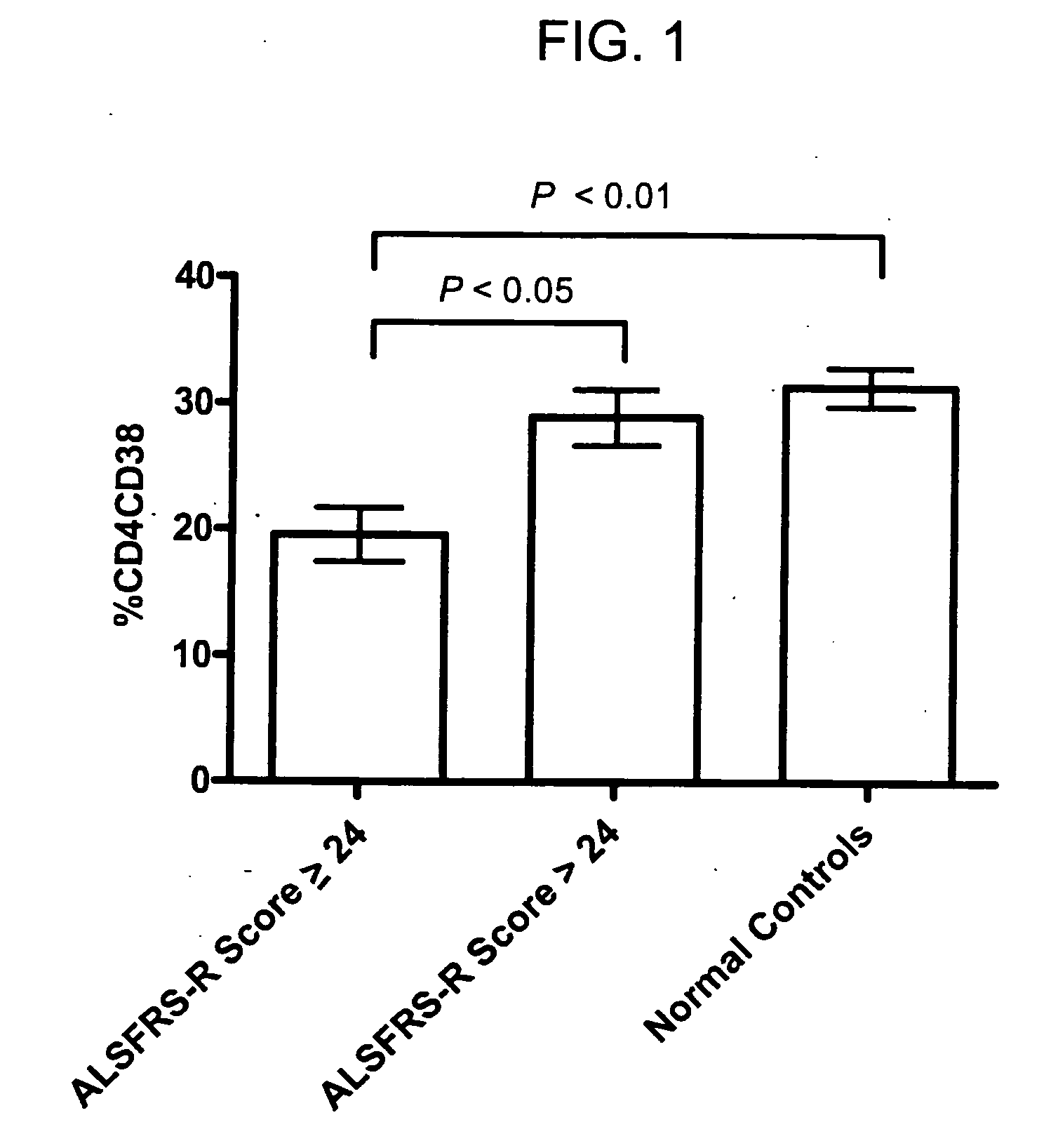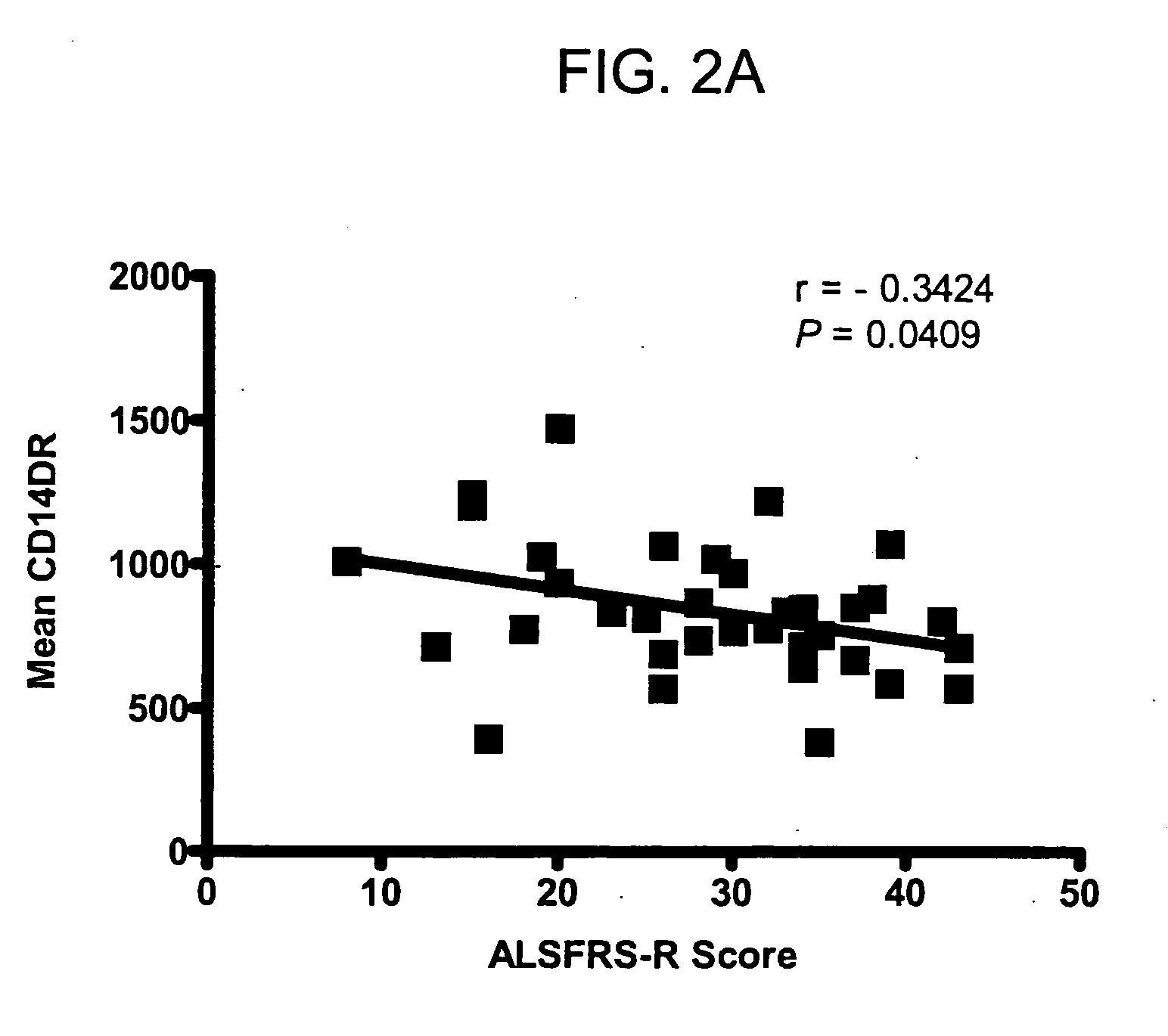Chlorite in the treatment of neurodegenerative disease
a neurodegenerative disease and chlorite technology, applied in the field of chlorite in the treatment of neurodegenerative diseases, can solve the problems of progressive weakness and paralysis of muscles, death, and few studies to date have explored the status of the systemic immune response, and achieve the effect of reducing the activation of blood immune cells
- Summary
- Abstract
- Description
- Claims
- Application Information
AI Technical Summary
Benefits of technology
Problems solved by technology
Method used
Image
Examples
example 1
Cross-Section Study of Immune Activation in ALS Patients Compared to Normal Subjects
[0114] A cross sectional study of immune activation was performed on blood from 40 patients diagnosed with ALS as compared to 37 controls with initial statistical analyses performed independent of drug treatment status. ALS blood cells showed abnormal levels of activation. Table 2 summarizes the results of this study.
TABLE 2Comparative analysis of serum antibodies and differentiation antigenexpression in blood of ALS patients and normal controlsNormalP ValueALS patientsControls(ALS vs.Parameter(n = 40)(n = 37 A)Controls)CD4 / CD8 ratio 2.84 ± 1.53 2.20 ± 0.980.0261% CD447.42 ± 8.03 37.99 ± 11.96% CD4CD38 27.14 ± 11.50 31.36 ± 10.690.0799Med CD4CD38 B 12.67 ± 14.24 18.83 ± 17.000.0784% CD820.45 ± 8.0119.85 ± 7.050.6986% CD8CD3813.35 ± 8.0912.03 ± 4.530.3620Med CD8CD38 B 3.30 ± 6.32 2.68 ± 4.180.6003% CD14 2.31 ± 0.99 3.25 ± 1.410.0002Mean CD14DR C 847.79 ± 228.55 566.59 ± 130.43CD14 SSC 465.9 ± 155.5...
example 2
CD4 T-Cell Activation is Decreased in Advanced ALS Disease
[0119] To test whether T lymphocytic activation would be related to duration or severity of disease, the T cell activation results were compared with the clinical ALS values shown in Table 1. To simplify clinical correlative analyses, patients were divided into two groups based on the ALSFRS-R scale (0-48, no disease=48). Those with severe impairment (an ALSFRS-R score of 0-24, n=10) were compared to those with milder impairment (ALSFRS-R score>24, n=26).
[0120] As shown in FIG. 1, T cell activation levels as quantitated by detection of CD38 antigens on the surface of CD4 T cells was significantly different between the two groups (P24). No significant disease associated changes were observed in any of the other T cell (CD4 or CD8) parameters measured.
example 3
Macrophage Activation and ALS Disease Progression
[0121] To evaluate whether systemic monocyte / macrophage activation would be related to duration or severity of disease, macrophage activation parameters from Table 2 were plotted against clinical measures of disease severity to test whether any disease specific changes would be present.
[0122] Levels of CD14 cells (as a proportion of total white cell count) did not vary between individuals with mild or severe disease. There was a significant correlation between the level of monocyte / macrophage activation with severity of disease defined by ALSFRS-R score (Pearson r=−0.3464, P=0.0409) (FIG. 2a).
[0123] When the rate of ALS disease progression (ALSFRS-R score change per month) was compared to CD14 cell HLA-DR expression, a direct and significant relationship was observed. FIG. 2b shows that higher CD14-DR levels were associated with a more rapid progression of ALS disease (Pearson r=0.3696, P=0.0265). Finally, the elevated level of mac...
PUM
 Login to View More
Login to View More Abstract
Description
Claims
Application Information
 Login to View More
Login to View More - R&D
- Intellectual Property
- Life Sciences
- Materials
- Tech Scout
- Unparalleled Data Quality
- Higher Quality Content
- 60% Fewer Hallucinations
Browse by: Latest US Patents, China's latest patents, Technical Efficacy Thesaurus, Application Domain, Technology Topic, Popular Technical Reports.
© 2025 PatSnap. All rights reserved.Legal|Privacy policy|Modern Slavery Act Transparency Statement|Sitemap|About US| Contact US: help@patsnap.com



